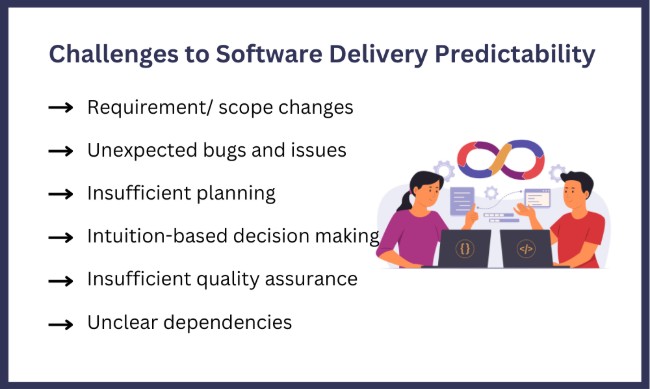How does automation impact software delivery predictability?
Status
answered
Status
answered
Many software delivery teams constantly face trouble with unforeseen delays, technical debt, and workflow inefficiencies and fail to maintain a steady release pattern. This struggle leads to unpredictable delivery timelines and affects both customer satisfaction and developer experience.
Software delivery predictability is your organization’s capability to release high-quality software consistently. Unpredictable software delivery tends to result in
In addition, unpredictability harms developers’ well-being, leads to burnout, and forces them to deliver lower-quality software to meet unrealistic goals and deadlines.
The following are several factors that contribute to unpredictability in the software delivery process.

When implementing best practices for software delivery, automation is a key player that enables organizations to standardize development pipelines, improve accuracy, and minimize human-induced errors, impacting delivery predictability more than ever.
Inconsistencies stemming from how code is written, tested, and deployed are a major source of unpredictability in software systems. Incorporating automation can minimize inconsistencies across teams by enforcing standardized practices to ensure teams are working within a predictable framework.
For instance, version control automation can help with consistent code integration and collaboration, whereas scripted deployment pipelines can help implement uniform deployment practices.
Testing and quality assurance are often neglected due to their time and resource-intensive nature. However, they are crucial to the software development life cycle, as early issue detection prevents costly complications in both time and money. Automated testing mitigates this by enabling frequent test cycles to catch code issues early and prevent recurring bugs in new releases.
Continuous integration (CI) ensures that the code changes are frequently merged so that fewer integration conflicts arise, while continuous deployment (CD) automates the deployment of validated code to production to maintain a steady release frequency. Rather than time-consuming manual builds and deployments where human errors can also be frequent, a well-implemented CI/CD pipeline can automate these processes and make the release cycles predictable.
Automation-driven real-time feedback loops and improved visibility throughout the delivery process are critical components in software delivery management. With the right tools, you can gain instant feedback on code changes via automated testing and CI/CD pipelines. Continuous monitoring provides alerts on failures and vulnerabilities, while automated code quality checks help maintain high standards. This enhances data-driven decision-making and improves delivery accuracy.
All in all, automation allows teams to shift from reactive firefighting to proactive planning, ensuring software delivery predictability with greater confidence.
Automation is a powerful tool that heavily impacts developer velocity, deployment frequency, early risk identification, and the entire software development life cycle in the modern tech world. Even though it takes careful planning, resources, and maintenance to implement, the long-term benefits significantly outweigh the challenges.
By reducing manual intervention, enforcing common standards, and providing greater real-time visibility, automation helps software delivery teams maintain a reliable release pattern and boost predictability.
